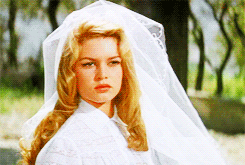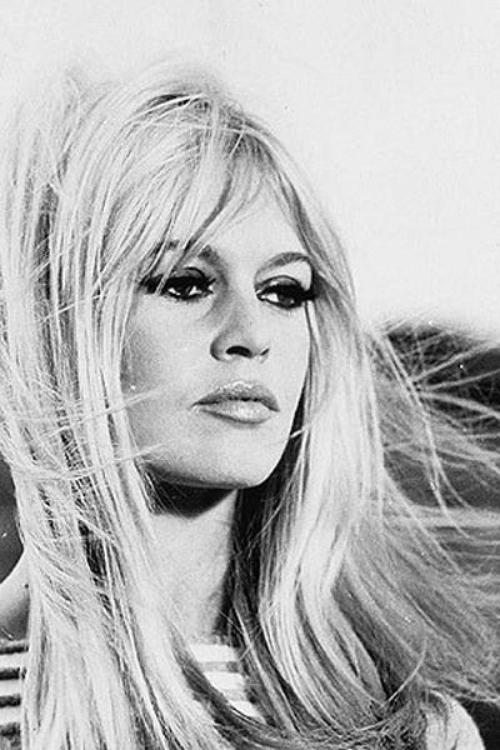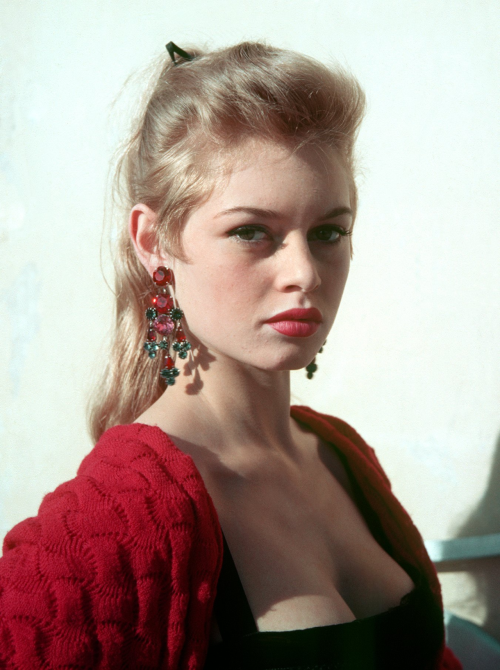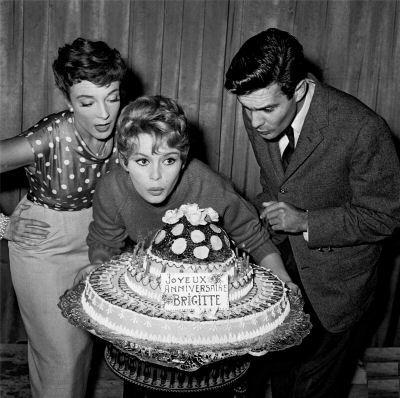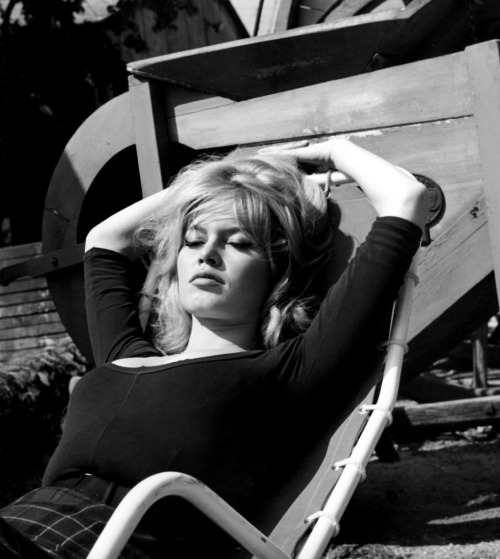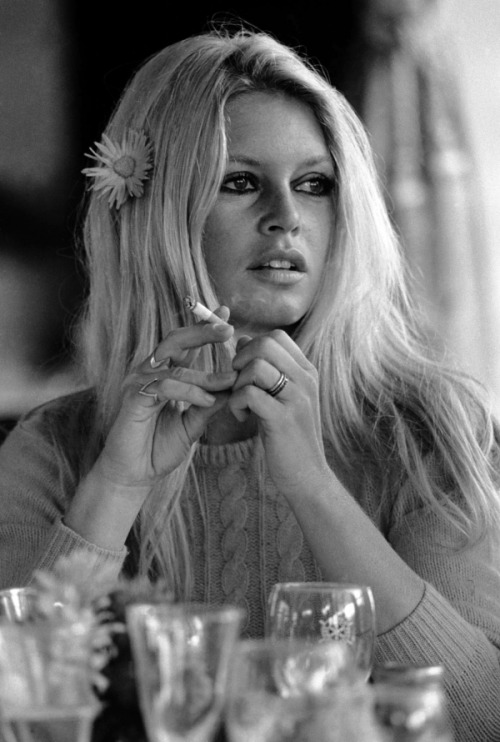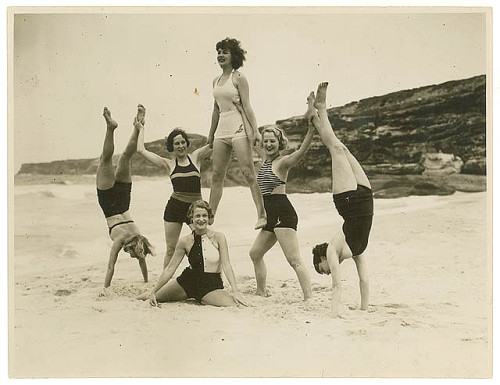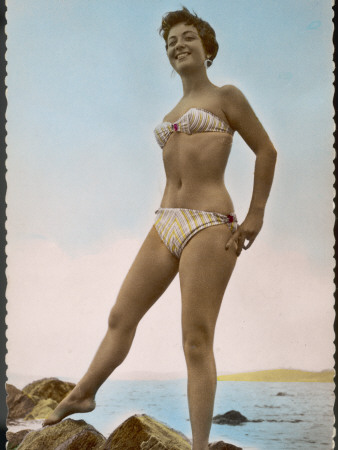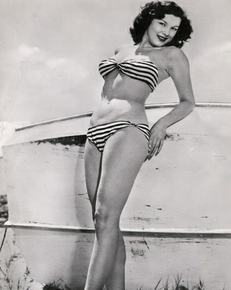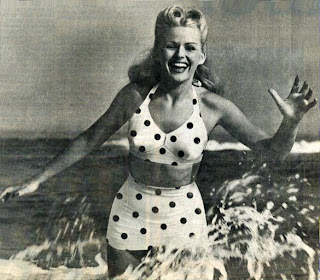Ah je l'aime beacoup <3, elle est parfaite!
viernes, 28 de septiembre de 2012
jueves, 27 de septiembre de 2012
It was an itsy bitsy teeny winnie yellow polka dots bikini!
Si nos ponemos a investigar, el origen del bikini se remonta a tiempos muy antiguos (cosa que me sorprendió). En la Antigua Grecia, las mujeres utilizaban el bikini para hacer deportes, y según pinturas y mosaicos, en Roma también se utilizaba. Este tipo de bañador no es el bikini regular, sino de un tipo de vestuario de dos piezas que dejaba el torso y las piernas al descubierto. Tuvo que correr mucha agua para la creación de la silueta del bikini como lo conocemos hoy, lo cual escribiré a continuación:
If we start to investigate the origin of the bikini it goes back to ancient times (which surprised me) in the Ancient Greece, women used bikini to do sports. Paintings and mosaics show Rome used it too. Such is not the regular bikini swimsuit, but a type of two-piece dress exposing the torso and legs. Much water had to run until the creation of the bikini silhouette as we know it today, which I will explain below:
Básicamente, las causas que influenciaron la evolución del bikini fueron primero, la necesidad de bañarse en publico, en épocas anteriores no era muy popular ir a la playa o al río. Por tanto, no había necesidad de crear una vestimenta para esta ocasión. Luego la comodidad y por supuesto factores culturales y sociales (Liberación Femenina, Moda, 1ra y 2da Guerra Mundial..etc). El primer bañador general, tanto para hombre como para mujer, aparece a finales de la época victoriana, en 1890 aproximadamente, y era una camisa, que cubría todo el brazo, pantalón hasta los tobillos y medias para cubrir los pies. La única diferencia era el material, la tela era un poco mas ligera que de costumbre, pero aun así super incomoda y poco practica. Mas tarde se fueron modificando un poco, retirando las medias para los hombres y acortando las mangas y agregando elementos según lo que estaba de moda.
Basically, the main issue that influenced the evolution of the bikini was the need to bathe in public, in earlier times it was not very popular to go to the beach or river. Therefore, there was no need to create an outfit for the occasion. Then of course the comfort and cultural and social aspects (Women Liberation, Fashion, 1st and 2nd World War). The first swimsuit, both for men and women, appears at the end of the Victorian era, in 1890 or so, and it was a shirt, covering the whole arm, ankle pants and socks to cover feet. The only difference was the material: the fabric was a little lighter than usual, but still super uncomfortable and impractical. Later they were modified slightly by removing the socks for men, shortening the sleeves and adding elements as it was fashionable.
Para la década de los 20, debido a la rebeldía que imperaba, el traje de baño se hizo mas corto (como las faldas y los vestidos) pero se cubría el tobillo y los pies porque no estaba permitido mostrar toda la pierna.
For the 20s, due to the prevailing rebellion, the swimsuit was shorter (like skirts and dresses) but covering the ankle and feet because it was not allowed to show that much leg.
En 1930 nace el traje de baño de dos piezas, ya muy cerca a lo que se convertiría el bikini original. La parte superior era con escote redondo, tipo camiseta y pantalones cortos hasta los muslos. Sin embargo, aunque mostraba mas piel, como estaba hecho de lana era muy pesado cuando se mojaba. Este modelo fue popular durante toda la década y hasta la siguiente.
In 1930 the two piece swimsuit is born, very close to what would become the original bikini. The top was a rounded neckline, and the bottom were shorts. But while showing more skin, since it was made of wool it was very heavy when it got wet. This model was popular throughout the decade up until the next one.
Este es un poco revelador/This one is a little revealing.
Ahora en los años 40, específicamente en 1946, el modisto Jacques Heim y Louis Reard colaboran e inventan el bikini de dos piezas, dejando al descubierto el torso y las piernas. Por supuesto, no tuvo gran aceptación al momento de su nacimiento, era insólito que la mujer mostrara tanta piel en publico, ya que todavía existian muchas limitaciones y prejuicios. El traje de baño de una sola pieza o de dos piezas (pero sin mostrar el ombligo)Ç era mas aceptado, y era la opción por excelencia. Pero la popularidad del bikini aumento a través de los años y mas luego de que se infiltrara su uso en el cine (con Brigitte Bardot, Esther Williams, Ursula Andress) y en la moda. Con la evolución de la moda y el surgimiento de nuevos tejidos, el bikini se vuelve cada vez mas codiciado. En los 50s se utilizan distintos patrones: puntos, animal print, rayas, strapless, con tirantes ajustables, y eran hechos mayormente de nylon. Rudi Gernreich dio mucho de que hablar en los 60s con su monokini, consistía en un traje de baño de una pieza que dejaba el busto al descubierto.
Now in the 40s, specifically in 1946, the couturier Jacques Heim and Louis Reard collaborate and invent the two-piece bikini, exposing the torso and legs. Of course, it was not widely accepted at the time of its birth, it was unacceptable for the woman to show much skin in public because there were still many limitations and prejudices. The one-piece or two-piece swimsuit without showing the navel was more accepted, and was the ultimate choice. But its popularity rised through the years and more after the use of it in films (with Brigitte Bardot, Esther Williams, Ursula Andress) and fashion. With the evolution of fashion and the rise of new fabrics, the bikini becomes increasingly coveted. In the 50s they used different patterns: dots, animal print, stripes, strapless, adjustable straps, and were made mainly of nylon. Rudi Gernreich gave a lot to talk about in the 60s with his monokini, it was a one piece swimsuit that left the breasts exposed.
Las versiones mas ''aceptables'' del bikini
miércoles, 22 de agosto de 2012
Underrated Fashion: The 1970's
Yes, to me the 70's are one of the most underrated decades when it comes to fashion (along with the 30's). People tend to only focus on the 50's, 60's or the tackiest of all times the 80's (mid and late 80's because early 80s are pretty decent). But i think, in my humble opinion, that this is one of the richest and most influential eras, the 70s saw the birth of numerous cultural movements which influenced both socially and in fashion. So, lets have a little peek at some 70's goodies, enjoy! <3
Si, para mi los 70 son una de las decadas mas subestimadas en lo que a moda se refiere (junto con los años 30). La gente solo se enfoca en los 50, 60 o en los años mas ordinarios los 80 (la mitad y los años finales de la decada, porque los primeros años son algo decentes). Pero creo que, en mi humilde opinion, los setenta son una de las eras mas ricas e influyentes, estos años vieron nacer numerosos movimientos culturales que influenciaron tanto socialmente como en el mundo de la moda. Entonces, veamos un poco de las bellezas que caracterizaban los 70s, disfruten!
And, of course i can't even write 70's without this WOMAN!
Y, por su puesto no puedo nisiquiera escribir 70s sin esta mujer!
Bianca Jagger
Or this <3
O esta <3
Farrah Fawcett
Mm i shall do a 70's icons post very soon :)
Debo hacer un post de iconos de los 70's pronto :)
martes, 21 de agosto de 2012
Fun Fact: 1940s Makeup
Did you know that in the 40s the known cat eyeliner wasn't popular? This is mistakenly believed and sometimes people use black or brown eyeliner this way to create a 40s look/make-up. In fact, women hardly used eyeliner, since there was so little on the market. Except for wealthy women or movie stars, ordinary women used very little or any at all. Mascara on the other hand was used a lot! It gave that elongated and sleepy look women in the 40s were looking for.
Sabían que en los 40 el conocido cat eye-liner no era muy popular? Hay una creencia errónea acerca de esto, y aveces a la hora de crear un look de esta época se usa delineador negro o marrón de esta forma. De hecho, las mujeres lo usaban muy poco, ya que casi no había en el mercado. Con la excepción de mujeres ricas o estrellas de cine, las mujeres normales usaban solo un poco o no lo utilizaban. La mascara sin embargo, se usaba mucho! Ayudaba a alargar la mirada, detalle propio del look que se quería crear en esta década.
Sabían que en los 40 el conocido cat eye-liner no era muy popular? Hay una creencia errónea acerca de esto, y aveces a la hora de crear un look de esta época se usa delineador negro o marrón de esta forma. De hecho, las mujeres lo usaban muy poco, ya que casi no había en el mercado. Con la excepción de mujeres ricas o estrellas de cine, las mujeres normales usaban solo un poco o no lo utilizaban. La mascara sin embargo, se usaba mucho! Ayudaba a alargar la mirada, detalle propio del look que se quería crear en esta década.
jueves, 9 de agosto de 2012
Eyebrows: Style them Vintage!
The Eyebrows, are my favorite part of the face, besides the lips. You can get them very thin, very arched, really bold or just leave them natural. I think the give an extra bit of faboulous to the whole makeup look. So lets have a little history at eyebrows through decades (the educational part: my fave :D) I'll skip 1900s-1910s because makeup was still a little bit of taboo and was just making its way through womens lives, so there wasn't much going on when it comes to makeup, eyebrows were kept pretty natural.
Las cejas, son mi parte favorita de la cara, además de los labios. Se pueden llevar muy delgadas, arqueadas, anchas o simplemente naturales. Creo que le dan el toque final al maquillaje. Así que vamos ver un poco de historia, y como se llevaban las cejas a traves de cada decada (la parte educativa: mi favorita: D) Dejare de lado los 1900s-1910s porque el maquillaje era todavía un poco tabú y apenas comenzaba a formar parte de la vida de la mujer, por lo que no había mucho que hacer cuando se trataba de maquillaje, solo que las cejas se llevaban muy naturales.
1920s:
Silent cinema was at its peak and so were the actresses in them. Since there was no sound, all emotions had to be expressed merely with the body and face, therefore make-up was a huge help (the use of make-up was now THE thing). So, the actresses kept or made their eyebrows flat and thin, neither rounded or arched just FLAT and slightly going downwards, this was crucial when they wanted to look puzzled or sad , and boy do they looked sad!. In fashion, flappers also adopted this look, but as the rebellious souls they were, the only difference was that they used a little bit more make-up on them.
El cine mudo estaba en su apogeo y también las actrices que participaban en las películas. Debido a que no había sonido, todas las emociones tenian que ser expresadas solamente con el cuerpo y la cara, por lo tanto el maquillaje fue de gran ayuda (el uso de maquillaje era ahora lo mas IT). Por lo tanto, las actrices llevaban sus cejas planas y delgadas, ni redondeadas o arqueadas, solo planas y ligeramente apuntando hacia abajo. Esto fue crucial a la hora de reflejar una mirada perpleja o triste. En la moda, las flappers también adoptaron esta estilo, pero como las rebeldes que eran, la única diferencia fue que utilizaban las cejas mucho mas maquilladas.
El cine mudo estaba en su apogeo y también las actrices que participaban en las películas. Debido a que no había sonido, todas las emociones tenian que ser expresadas solamente con el cuerpo y la cara, por lo tanto el maquillaje fue de gran ayuda (el uso de maquillaje era ahora lo mas IT). Por lo tanto, las actrices llevaban sus cejas planas y delgadas, ni redondeadas o arqueadas, solo planas y ligeramente apuntando hacia abajo. Esto fue crucial a la hora de reflejar una mirada perpleja o triste. En la moda, las flappers también adoptaron esta estilo, pero como las rebeldes que eran, la única diferencia fue que utilizaban las cejas mucho mas maquilladas.
1930s:
30s kept the same line, but eyebrows became rounder and thiner. Some women, tweezed all their natural eyewbrow and drew a new one: higher, rounder, longer and thiner than usual. As mentioned above, this style made facial expressions really shocking (with the arrival of the talkies, this wasn't a big deal anymore). This time, rounder eyebrows helped look more surprised, amazed and even happier. Again, fashion takes cinema as reference but this style wasnt adopted by EVERY woman, neither was suitable for all(little bit clownish for my taste :/ ).
En los 30s se mantuvo la misma línea, pero las cejas ahora eran mas redondas y finas. Algunas mujeres, depilaban con pinza sus cejas naturales y las dibujaban de otra manera: más altas, más redondas, más largas y mas delgadas que de costumbre. Como se mencionó anteriormente, este estilo resaltaba las expresiones faciales y hacia que fueran mas impactantes (con la llegada del cine sonoro, esto no fue algo tan relevante). Esta vez, las cejas redondeadas ayudaban con expresiones de sorpresa, asombro y felicidad. Una vez más, la moda toma el cine como referencia, pero este estilo no fue adoptado por todas las mujeres cotidianas, ni tampoco era adecuado para todo tipo de rostro.
30s kept the same line, but eyebrows became rounder and thiner. Some women, tweezed all their natural eyewbrow and drew a new one: higher, rounder, longer and thiner than usual. As mentioned above, this style made facial expressions really shocking (with the arrival of the talkies, this wasn't a big deal anymore). This time, rounder eyebrows helped look more surprised, amazed and even happier. Again, fashion takes cinema as reference but this style wasnt adopted by EVERY woman, neither was suitable for all(little bit clownish for my taste :/ ).
En los 30s se mantuvo la misma línea, pero las cejas ahora eran mas redondas y finas. Algunas mujeres, depilaban con pinza sus cejas naturales y las dibujaban de otra manera: más altas, más redondas, más largas y mas delgadas que de costumbre. Como se mencionó anteriormente, este estilo resaltaba las expresiones faciales y hacia que fueran mas impactantes (con la llegada del cine sonoro, esto no fue algo tan relevante). Esta vez, las cejas redondeadas ayudaban con expresiones de sorpresa, asombro y felicidad. Una vez más, la moda toma el cine como referencia, pero este estilo no fue adoptado por todas las mujeres cotidianas, ni tampoco era adecuado para todo tipo de rostro.
1940s
Plucking reduced to little bit of grooming to leave a natural yet polished look. A little pencil was used too, and just the round and arched shape of the 30s remained, but in a much more wearable way. This style matched with the minimal look cinema starlets adopted, and with WW2 and the lack of makeup in the market, this was the look they created. This affected fashion industry too, so this became a popular style.
La depilacion se reduce a un poco de ¨limpieza¨ para dejar un aspecto natural y a la vez pulido. Un poco de lápiz para cejas era aceptable y solo mantuvo la forma redondeada y el arqueada de los años 30, pero de una manera mucho más usable. Este estilo coincidia con el look minimalista de las estrellas de cine y con la 2 ª Guerra Mundial y la falta de maquillaje en el mercado, este era el aspecto que se podia crear. La industria de la moda se vio afectada también, así que el look se adopto de manera general.
1950s
1950s
Ahh! War is over for good, and we are back to step 1; The 20s and its make-up explotion: Compacts powder, liquid foundation, plenty mascara brands, eyebrow and eye pencil, thousands of eyeshadows and colors to play with. These were the most typical styles: Bold and thick eyebrows, Natural yet arched eyebrows and the ones that were left plain natural. Im a big fan of the first group! If you wanted to look young, playful and sweet, the bold ones were the one for you; Audrey Hepburn was the master at achieving this look (Elizabeth Taylor had my favorite). On the sassy and sexy side, the natural and arched were the right choice for it, Ms. Monroe used this type of eyebrow look. Grace Kelly or Donna Reed are the examples for the natural ones. They were all different, but almost all were groomed and had a medium width, nothing too extreme.
La guerra ha terminado para siempre, y estamos de vuelta al paso 1, los años 20 y su explosión de cosméticos: polvos compactos, base líquida, mascaras de pestañas, lápiz para ojos y cejas, sombras de ojos e infinidad de colores para combinar. Estos fueron los estilos más característicos: las cejas anchas y gruesas, cejas arqueadas pero naturales y las que se dejaban al natural. Soy una gran fan del primer grupo! Si querias parecer joven, juguetona y dulce, las cejas gruesas eran las ideales. Audrey Hepburn era una maestra en crear este estilo (Elizabeth Taylor tenía mis favoritas). En el lado atrevido y sexy, las naturales y arqueadas eran la mejor opción para este look, Marilyn Monroe utilizó este tipo cejas. Grace Kelly o Donna Reed llevaban ejemplos de lass cejas naturales. Eran todas diferentes, pero tenian en común el ancho y la forma de depilación.
1960s: The first part of the decade mantained a similar look to the 50s, being the transitional years. Movie Stars kept this look too, and women emulated their make-up. But Fashion and cultural movements made this change in the mid 60s: plucking and even shaving eyebrows was very common. Since eye make-up was the main focus, eyebrows were reduced to all or nothing. Some kept their natural eyebrows and even fill them with pencil, others shaved them completely and sometimes drew a fine line, but nothing that could take the bold eyes it's shine.
La primera parte de la década mantuvo una apariencia similar a los años 50, siendo los años de transición. Las estrellas de cine tenian este aspecto también, y las mujeres emulaban su maquillaje. Pero los movimientos culturales y la moda cambiaron este patron a mediado de la decada: depilar e incluso afeitarse las cejas era muy común. El maquillaje de ojos era el foco principal, las cejas se reducían a todo o nada. Algunas chicas mantenían sus cejas naturales, e incluso las rellenaban con lápiz, otras las afeitaban por completo y, a veces, dibujaban una línea muy fina pero nada que robara el protagonismo del maquillaje de los ojos.
Suscribirse a:
Entradas (Atom)

